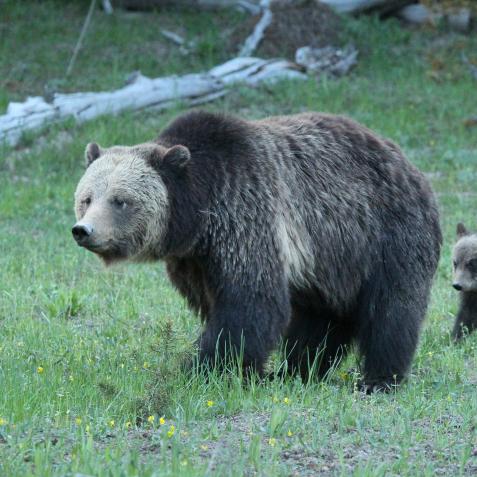
wellsie82
Species Loss is a Disaster for Wildlife and Humankind
Biodiversity and species loss is a grave threat, facing not only animals and plants but society too. Ecologists say that losing species directly affects human food production, water supply, building materials, and energy sources, so our interactions with and handling of ecosystems must be regulated.
An experiment led by German scientists found that food, water, and other crucial life systems rely on biodiversity to regulate plant growth and the stability of material cycles–the movement of nutrients, carbon, nitrogen, and sulfur between living organisms and the environment.
The Jena Experiment confirmed that a healthy ecosystem provides for human needs, requires a lot of diverse plant species, and that any losses have severe impacts, such as flood, drought, or groundwater pollution.
This adds to a United Nations report in 2018 detailing the main threats to humans and suggesting paths to a more sustainable future. Chair of the Intergovernmental Science-Policy Platform on Biodiversity and Ecosystem Services, Robert Watson said Earth was losing species at an unsustainable rate–more than 1,000 times the natural speed of evolution.
Habitat destruction and unsustainable farming practices, such as overuse of pesticides and herbicides, are triggering species decline and extinction. “As we continue to degrade our environment, it's not just an environmental issue, it's also a development issue,” said Watson. “So, the challenge we have is how can we meet the food needs, the water needs, and the energy needs in a way that doesn't destroy biodiversity and nature.”
The economic value of America’s land-based nature contribution to society is estimated at more than $24 trillion each year, the report revealed, but 65% of these contributions are in decline, with 21% in real trouble. The National Wildlife Federation says hundreds of species are on extinction watch lists.
Starting Small

Landscapes, Seascapes, Jewellery & Action Photographer
Rare pink meadow grasshopper with a rare genetic mutation called erythrism, making the grasshopper "hi-vis" and easy prey for birds, so reaching adulthood is an amazing achievement.
Simply focusing on one group of animals, the insects, shows a stark reality. In 2019, a scientific study suggested that half of all insects worldwide have been wiped out since 1970. More than 40% of species are facing extinction, and their disappearance would lead to a total collapse of nature.

Juergen Ritterbach
Galapagos Land Iguana (Conolophus subcristatus)
Insects are largely unseen, but they feed many other species of birds, amphibians, reptiles, and fish. They also pollinate many crops and fruit-bearing plants, help to recycle organic matter for healthy soil, and contribute to human medicines.
Geologically, we are living in the anthropocene period–-the epoch when mankind began to have a significant effect on the planet’s ecosystems. Studies of our recent impacts, besides insect life, include major declines in plant life and animal populations. In the past decade, the world hasn't met a single target to halt ecosystem destruction.
Getting Warmer

Freder
Bengal Slow Loris (Nycticebus bengalensis)
Vertebrate species, of which humans are only one, are on the brink of extinction, according to one study. The International Union for the Conservation of Nature lists more than 32,000 species in total that are threatened with extinction. And the organization says that despite the growth of protected areas, national governments have simply not met their conservation commitments.
One of the most effective tools for reversing these trends is to compel the financial sector to stop treating nature’s assets as free for exploitation. Last year, more than $2.6 trillion was invested by the world’s largest banks in sectors that drive biodiversity destruction.
More on Wildlife and Sustainability
Stream on discovery+Prince William: A Planet For Us All Gallery 5 Photos
Growing up with a deep connection to the natural world, The Duke of Cambridge embarks on a royal mission to save the planet in Prince William: A Planet for Us All. Don't miss the premiere of Prince William: A Planet for Us All is streaming on discovery+. Available in US only.
See the World Through a Mysterious Lens 52 Photos
The world if full of magical and mysterious creatures and places. Narrated by David Schwimmer, MYSTERIOUS PLANET is an epic journey to the ends of the earth. Combining humor with the awe and beauty of the natural world, this series looks to unlock the greatest mysteries behind the world's most incredible species. Explore these amazing images of our mysterious planet. And stream MYSTERIOUS PLANET now, only on discovery+.
Dame Judi Dench Experiences the Borneo Jungle 10 Photos
Dame Judi Dench and conservationist David Mils are setting out on a trip of a lifetime to uncover the lush rainforests, magical wildlife, and spectacular coastlines of Malaysian Borneo on JUDI DENCH'S WILD BORNEO ADVENTURE. Take a peek at photos from their adventure. You can stream JUDI DENCH'S WILD BORNEO ADVENTURE only on discovery+.
Global sustainability reporting can be used to account for environmental damage and identify the risks of business activity, from the smallest firms to the largest corporations. Governments can do more to reverse the damage that has been done through rewilding projects and more.
Captive breeding programs can offer support for threatened species, through sperm and egg biobanking and even human fertility technologies like IVF. But the World Wildlife Fund goes further and maps out changes to human consumption habits, dietary changes, and restrictions on land conversion to reverse biodiversity decline by 2050.





















